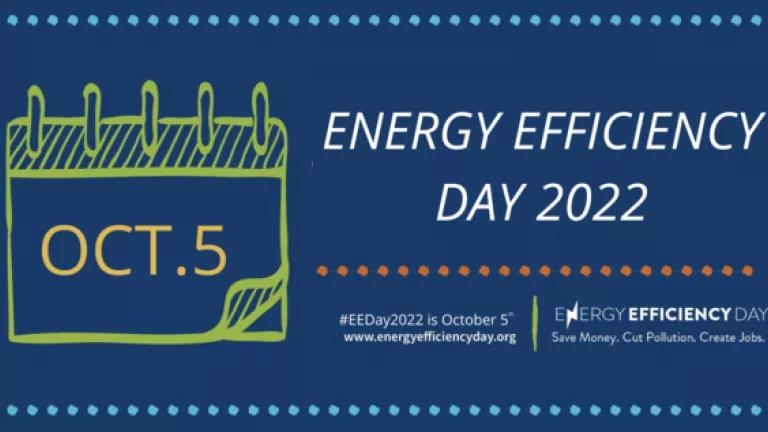
Today is energy efficiency day, and there may be more ways to think about energy efficiency than you think! One critical aspect is the Department of Energy’s (DOE) energy efficiency standards program, which establishes minimum energy efficiency requirements for dozens of products. We’ve long known that this program provides enormous benefits to consumers and the environment.
The choices that we all make as consumers are another important aspect of energy efficiency. While DOE sets minimum efficiencies, it’s always a great idea to look for even more efficient products if that is an option for you. Sometimes it’s just a matter of buying a more efficient version of a product. Buying a more efficient, Energy Star qualified dishwasher, for instance, will save you about $35 per year and nearly 4000 gallons of water over the life of the product.
Sometimes, however, it pays to think about buying a different kind of product that can meet the same need. For example, consider the difference between buying a gas furnace and a heat pump. Even an efficient gas combustion furnace tops out at about 95% efficiency. Heat pumps, however, are like air conditioners running in reverse and are inherently much more efficient.
Rather than combusting a fuel to create heat, heat pumps use a bit of energy to take heat from outside and move it into your home. Think of them as using a little bit of electricity to move a lot of heat from the outdoor air, which is warmed by the sun, and transfer it indoors. (And even better, heat pumps run as an air conditioner in the summer and a heater in the winter, replacing two appliances with one.)
So, while gas efficiency is still important, if you are committed to an energy-efficient home, you should consider electrifying. Replacing that gas furnace or water heater with a heat pump version will result in a much greater efficiency gain than simply buying a more efficient gas product. And with recently passed rebates and tax credits in the Inflation Reduction Act, there’s never been a better time to do so.
“Natural” Gas prices
Another reason to make the switch from gas to electric is that it will be good for your pocketbook. As customers move to more efficient electric options, gas prices could substantially increase in the coming decades due to infrastructure costs being spread among fewer customers.
When you pay your gas bill, a large part of it goes toward the quantity of gas you consumed that month – think of that as the cost of gas as a commodity. But the cost of delivering gas to your home isn’t just the price of gas a commodity. It is also influenced by the cost of maintaining the infrastructure – picture the series of pipelines that take gas across the country and deliver it to your home. Part of your bill goes toward paying for, and maintaining that infrastructure.
When there are lots of gas customers, those costs are spread over many people and the cost to each consumer is low. But consider what happens as people start to use less gas, or disconnect from the system entirely. Gas utilities will face similar infrastructure costs but with a smaller customer base and revenue stream. That means each customer must now pay a higher bill simply to cover the cost of keeping a gas distribution system in place.
This can then become a death spiral – as gas prices spiral upward, more people will leave, which means prices continue to go up for remaining customers, which leads to more departures, and so on.

This figure shows how regional average residential delivered gas prices may change in the future as customers pay an increasing share of infrastructure costs. For the full details of this analysis, including an explanation of the assumptions used and scenarios examined, please see NRDC’s full comments here.
NRDC recently analyzed gas price increases as part of arguing for strengthening energy efficiency standards for water heaters. We found that in some parts of the country, gas prices could increase by 6 to 7 times over current Energy Information Administration forecasts in the Annual Energy Outlook. (Depending on the specific assumptions made, these increases can be even greater) You can read more about our analysis and conclusions here.
While it is essential to ensure that this process is managed well, and that lower income consumers who can least afford a heat pump aren’t stuck with the cost of maintaining an entire gas distribution network, the best way to avoid spiraling gas prices in the years to come is to switch to heat pumps as soon as your gas furnace or water heater need to be replaced.
Furnaces
Currently, DOE is in the process of considering upgraded efficiency standards for residential gas furnaces. DOE has put forward a strong proposal, and we support it. DOE has projected benefits of $500 for the average household if these stronger efficiency standards are put in place. It is important to note, however, that these benefits are very likely an underestimate. In a world with steeply rising gas prices, gas efficiency becomes more important. And while we encourage folks who can to choose an inherently more efficient product, those who stick with gas for the time being will be much better off if they can get the most efficient one possible.
Conclusion
As you can see, there is more to energy efficiency than buying a more efficient version of a product. Sometimes it’s buying a different type of product entirely. While gas efficiency is important, this Energy Efficiency Day we encourage those looking for the most efficient appliances to consider switching to heat pumps whenever possible.




